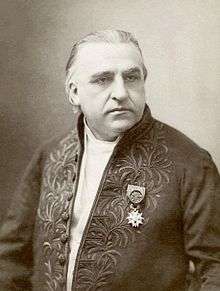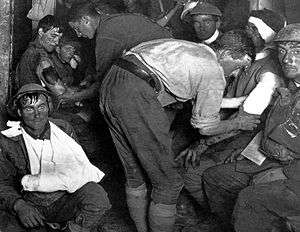Male hysteria
In the nineteenth and early twentieth century, (female) hysteria was a common psychiatric diagnosis made primarily in women. The existence and nature of a purported male hysteria (hysteria masculina[1]) was a debated topic around the turn of the century. The notion of male hysteria was initially connected to the post-traumatic disorder known as railway spine; later, it became associated with war neurosis.
History
In the second half of the nineteenth century, hysteria was well-established as a diagnosis for certain psychiatric disorders. Although the original anatomical explanation of hysteria, the so-called wandering womb, was by this point abandoned, the diagnoses remained associated with (gender stereotypes of) females and female sexuality in the minds of physicians.[2]:24 Hysteria was joined in 1866 by a diagnosis for a very similar set of symptoms: railway spine, a nervous disorder caused by witnessing the accidents that the dangerous railways of the time generated in large numbers. John Eric Erichsen, who first diagnosed railway spine, explicitly rejected the hysteria diagnosis for his patients, arguing that diagnosing men with hysteria was unreasonable, "this term [being] employed merely to cloak a want of precise knowledge as to the real pathological state".[2]:25 Herbert Page, by contrast, argued for the hysteria label, finding what Erichsen called railway spine a functional disorder that was too similar to hysteria to warrant a separate diagnosis.[3]:438
The situation gradually began to change: in 1859, Paul Briquet remarked that "we saw little hysteria in men because we did not want to see it",[4]:193 and between 1875 and 1902, some three hundred medical articles were devoted to the topic of male hysteria, as well as dozens of dissertations.[4]:180

Statistical work in the 1880s finally turned the conception of hysteria on its head. In 1882, Jean-Martin Charcot had made a "radical" move by citing Briquet's estimate of hysteria having a 1:20 ratio of incidence in males compared to females,[4]:183 and added a section for male sufferers of hysteria to his Paris hospital, the Salpetrière.[2]:25 A subsequent German study came up with a 1:10 ratio, Georges Gilles de la Tourette then published a 1:2 or 1:3 estimate, and finally Charcot and his student Pierre Marie did a study of 704 cases of patients displaying symptoms of hysteria, finding that 525 of them were males.[4]:183 Before long, the French army became interested in the diagnosis and the nervous condition of its soldiers. Despite the notion of hysterical soldiers clashing with nationalist and revanchist ideas of the time, diagnoses of hysteria were soon made by military medical personnel.[4]:186 Male "traumatic hysteria", as defined by Charcot, was a distinct disease from female hysteria in that it was linked to traumatic shock rather than sexuality or emotional distress, so the gendered stereotyping was still at work in Charcot's thinking.[2]:26–27 This new category subsumed what British and American physicians had understood as railway spine.[3]:439
From Paris, Charcot's theories traveled east, carried by visitors to Charcot's hospital: the Germans Max Nonne and Hermann Oppenheim, and the Austrian Sigmund Freud. Nonne was originally skeptical, but ultimately became a proponent of the male hysteria diagnosis when dealing with the neurotics produced by the First World War. Oppenheim, on the other hand, was critical of Charcot's theories and sought to distinguish "traumatic hysteria" from "traumatic neurosis";[2]:29 he and his colleague Thomsen found that the symptoms in their cases of railway spine were different enough from what was regarded as the symptoms of hysteria, at least in severity.[3]:438
Freud, in 1886, gave a paper about the topic of male hysteria to the Imperial Society of Physicians in Vienna.[3]:437 By this point, the incidence of "classical" hysteria in males was accepted by Freud's audience, but Charcot's traumatic variant was still controversial and evoked discussion among the present medical doctors.[3]:438–440 In later works, Freud would reject Charcot's distinction between the two types of hysteria, arguing that trauma is the cause of hysteria in both men and women, though he broadened the definition of trauma to include repressed memories of sexual experiences, and believed that recalling traumatic memories could cure hysteria.[5]:315 Freud even diagnosed himself and his brother with hysteria, but eventually dropped his own efforts and reverted to a theory of hysteria as a condition of the female body.[6]:173 His followers similarly would exhibit a gendered view of hysteria, associating it with latent homosexuality and the Oedipus complex.[5]:324
In Britain, Charcot's theories took on a different guise when it was suggested that hysteria in men was a disease of the "Latin races", to which Anglo-Saxon men were virtually immune. In Germany, too, a majority of the medical profession rejected Charcot's ideas, and medical journals circulated papers that labeled French men as more prone to hysteria than Teutons — "which, in the context of the time, meant that they were weaker, less virile, and more susceptible to degeneration".[4]:201 An 1889 case study of hysteria in a German soldier gave the French doctors the ammunition they needed for a counterattack.[4]:203 Aside from French and Germans, indigenous inhabitants of various remote regions, colonial populations, Jews and (retroactively) pre-Civil War American slaves were charged with high incidence rates of hysteria by European and white American doctors and anthropologists.[4]:205–207

Toward the end of the century, female hysteria became increasingly an anti-suffragist label in the popular press and came under attack from rising feminism, while the wars of the early twentieth century brought new attention to the male variant. The Boer War and the Russo-Japanese War produced hysterical symptoms in veterans in large enough numbers that in 1907 the label "war neurosis" was introduced to describe their specific condition. For the disorders seen in World War I veterans, additional terms such as shell-shock (coined by Charles Samuel Myers), and (in France) pthiatiques and simulateurs were invented to prevent labeling soldiers with the "feminizing" label of hysteria.[5]:320–2 Charcot's earlier work, meanwhile, was ignored, and shell-shock sufferers were regarded by their physicians as displaying the symptoms of "womanish, homosexual or childish impulses".[5]:324
Today, male hysteria is no longer a recognized illness, but different manifestations of hysteria are recognized in other conditions such as schizophrenia, borderline personality disorder, conversion disorder, and anxiety attacks.
See also
References
- ↑ Francis Hopkins Ramadge (1835). Asthma, its species and complications; or, Researches into the pathology of disordered respiration. p. 324.
- 1 2 3 4 5 Lerner, Paul Frederick (2003). Hysterical Men: War, Psychiatry, and the Politics of Trauma in Germany, 1890–1930. Cornell University Press.
- 1 2 3 4 5 Ellenberger, Henri F. (2008) [1970]. The Discovery of the Unconscious. Basic Books.
- 1 2 3 4 5 6 7 8 Micale, Mike S. (2009). Hysterical Men: The Hidden History of Male Nervous Illness. Harvard University Press.
- 1 2 3 4 Showalter, Elaine (1993). "Hysteria, Feminism and Gender". Hysteria Beyond Freud. University of California Press.
- ↑ Eng, David L. (2001). Racial Castration: Managing Masculinity in Asian America. Duke University Press.